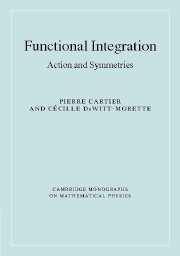Book contents
- Frontmatter
- Contents
- Acknowledgements
- List of symbols, conventions, and formulary
- PART I THE PHYSICAL AND MATHEMATICAL ENVIRONMENT
- PART II QUANTUM MECHANICS
- PART III METHODS FROM DIFFERENTIAL GEOMETRY
- PART IV NON-GAUSSIAN APPLICATIONS
- PART V PROBLEMS IN QUANTUM FIELD THEORY
- 15 Renormalization 1: an introduction
- 16 Renormalization 2: scaling
- 17 Renormalization 3: combinatorics, contributed by Markus Berg
- 18 Volume elements in quantum field theory
- PART VI PROJECTS
- APPENDICES
- Bibliography
- Index
15 - Renormalization 1: an introduction
from PART V - PROBLEMS IN QUANTUM FIELD THEORY
Published online by Cambridge University Press: 04 November 2009
- Frontmatter
- Contents
- Acknowledgements
- List of symbols, conventions, and formulary
- PART I THE PHYSICAL AND MATHEMATICAL ENVIRONMENT
- PART II QUANTUM MECHANICS
- PART III METHODS FROM DIFFERENTIAL GEOMETRY
- PART IV NON-GAUSSIAN APPLICATIONS
- PART V PROBLEMS IN QUANTUM FIELD THEORY
- 15 Renormalization 1: an introduction
- 16 Renormalization 2: scaling
- 17 Renormalization 3: combinatorics, contributed by Markus Berg
- 18 Volume elements in quantum field theory
- PART VI PROJECTS
- APPENDICES
- Bibliography
- Index
Summary
Introduction
The fundamental difference between quantum mechanics (systems with a finite number of degrees of freedom) and quantum field theory (systems with an infinite number of degrees of freedom) can be said to be “radiative corrections.” In quantum mechanics “a particle is a particle” characterized, for instance, by mass, charge, and spin. In quantum field theory the concept of a “particle” is intrinsically associated to the concept of a “field.” The particle is affected by its own field. Its mass and charge are modified by the surrounding fields, namely its own and other fields interacting with it.
In the previous chapters we have developed path integration and its applications to quantum mechanics. How much of the previous analysis can be generalized to functional integration and its applications to quantum field theory? Gaussians, time-ordering, and variational methods, as presented in the previous chapters, are prototypes that are easy to adapt to quantum field theory. We shall carry out this adaptation in Section 15.2.
However, the lessons learned from quantum mechanics do not address all the issues that arise in quantum field theory. We introduce them in Section 15.3. We use the example, due to G. Green, of pendulum motion modified by a surrounding fluid [1].
Information
- Type
- Chapter
- Information
- Functional IntegrationAction and Symmetries, pp. 289 - 307Publisher: Cambridge University PressPrint publication year: 2006
